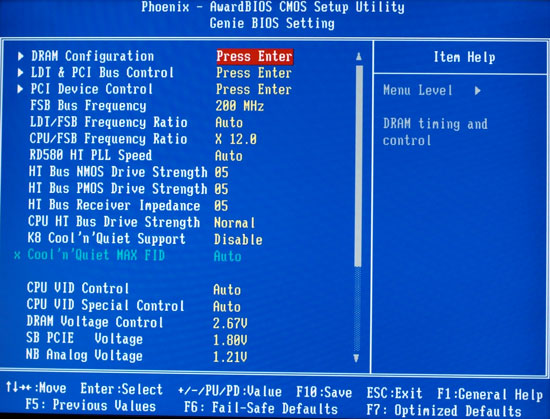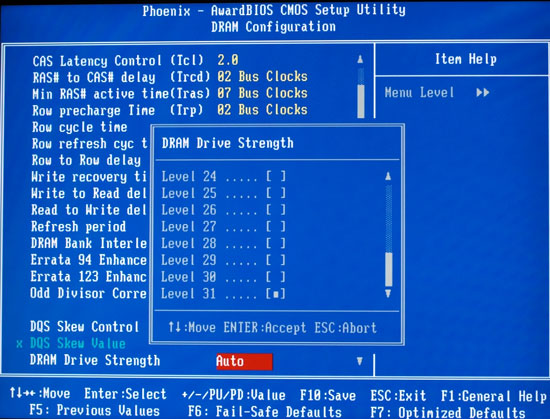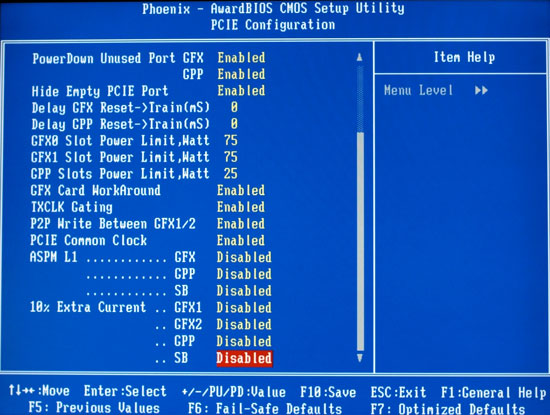DFI CFX3200-DR: ATI RD580 Tweak Attack
by Wesley Fink on May 8, 2006 12:05 AM EST- Posted in
- Motherboards
Basic Features
| DFI CFX3200-DR Features | |
| CPU Interface | Socket 939 Athlon64 |
| Chipset | ATI RD580 Northbridge - ULi M1575 Southbridge |
| Bus Speeds | 0 to 500 in 1MHz Increments |
| Memory Speeds | DDR200,240,266,280,300,333,360,400 (433,466,500 with Rev. E AMD) |
| PCIe Speeds | 100 to 150 in 1MHz Increments |
| PCI/AGP | Fixed at 33/66 |
| Core Voltage | Auto, 0.8V to 1.55V in 0.025V increments PLUS VOLTAGE x 101.4%, 102.9%, 104.3%, 105.8%, 107.2%, 108.6%, 110.0%, 111.5%, 113.0%, 114.4%, 115.8%, 117.3%, 118.7%, 120.2%, 121.6% (Maximum vCore 1.88V) |
| CPU Clock Multiplier | 4x-25.0x in 0.5X increments |
| DRAM Voltage | 2.06v to 4.15v in .01v to .03v increments |
| HyperTransport Frequency | 1000MHz (1GHz) (Stable in overclocking to 1500+ HT) |
| HyperTransport Multiplier | Auto, 1X to 5X |
| Northbridge Over-Voltage: | Auto, Disabled, Enabled Enabled adds 3 additional voltage options below |
| NB Core Voltage | 1.21v, 1.34v, 1.47v, 1.60v |
| NB Analog Voltage | 1.21v, 1.34v, 1.47v, 1.60v |
| HyperTransport Bus Voltage | 1.21v, 1.34v, 1.47v, 1.60v |
| SB PCI Express Voltage | 1.8v, 1.85v, 1.9v, 1.95v |
| GFX1/2 (PCIe) Link Width | X16,x12,x8,x4,x2,x1 |
| GFX and/or SB Payload | 64,32, or 16 Bytes |
| Delay GFX Reset | 0 to 200mS in 1mS increments |
| Delay GPP Reset | 0 to 200mS in 1mS increments |
| GFX 1 and/or 2 Slot Power Limit | 0 to 250 watts in 1 watt increments |
| GPP Slot Power Limit | 0 to 250 watts in 1 watt increments |
| +10% Extra Current | GFX1,GFX2,GPP, and/or SB |
| RD580 HT PLL Speed | Auto, High Speed, Low Speed |
| HT Bus NMOS Drive Strength | 00-31 in 1 increments (32 Settings) |
| HT Bus PMOS Drive Strength | 00-31 in 1 increments (32 Settings) |
| HT Bus Receiver Drive Strength | 00-31 in 1 increments (32 Settings) |
| AMD Cool'n'Quiet | Auto, Disable |
| Cool'n'Quiet Max FID | Auto, 8.0x to 13x in 0.5x increments |
| Memory Slots | Four 184-pin DDR DIMM Slots Dual-Channel Configuration Regular Unbuffered or ECC Memory to 4GB Total |
| Built-In Memory Test | Disabled, Enabled |
| DQS Skew Control | Increase (+) or Decrease (-) -255 to 255 in 1 increments |
| Expansion Slots | 2 PCIe X16 2 PCIe X1 3 PCI Slots |
| Onboard SATA/RAID | 4 SATA2 Drives by ULi M1575 (RAID 0,1,1+0,5,JBOD) 4 SATA Drives by Silicon Image 3114 (RAID 0,1,0+1,JBOD) |
| Onboard IDE/IDE RAID | Two Standard ATA133/100/66 (4 drives) |
| Onboard USB 2.0/IEEE-1394 | 8 USB 2.0 ports supported by ULi M1575 2 Firewire by VIA VT6307 |
| Onboard LAN | PCIe Gigabit by Marvel Yukon 88E8052 PCIe Gigabit by Marvel Yukon 88E8053 |
| Onboard Audio | Azalia HD Karajan Audio Module powered by Realtek ALC882 codec |
| BIOS Revision | Award 417 (4/17/06) |
There is a very good reason that the Basic Features chart is the largest we have ever created for a review. DFI has a reputation for providing a huge array of adjustments on their enthusiast-oriented motherboards, and it normally is a challenge to describe the range of adjustments available on DFI motherboards. The CFX3200-DR takes that to a new level, however, with the widest and finest adjustments ever seen on a production motherboard. Despite the size of the expanded features table, we still couldn't include everything you can adjust on this DFI. This will be welcomed news to those that want to test and control every aspect of their computing experience.

DFI uses the familiar Award BIOS to control the DFX3200. Most adjustments of interest to overclockers and enthusiasts will be found under the "Genie BIOS Setting" sub-menu. Adjustments are so extensive they require 2 pages for base options.


Additional submenus under the Genie Settings include a full range of DRAM controls, with every setting for menu you could imagine - and a few more you probably didn't even know existed. These include skew control with 511 adjustment levels (+/- 255 steps).

DRAM drive strength includes 31 discrete levels of drive strength. No one will ever complain about lack of control on the DFI CFX3200. We are fans of extensive adjustment options in the BIOS, but the DFI may take things too far for some enthusiasts. There need to be more auto settings that work for the great majority of users. Users can then go deeper if they choose, with confidence the "auto" settings will get them going.
Since the CFX3200 was first received there have been several BIOS revisions. The shipping BIOS had issues with many memory types and would not even boot with some memories. The BIOS used in this review, the 417, worked well with almost any memory we had for testing, but it took several revisions to get there. As with past DFI boards you will likely find a huge number of custom BIOS revisions floating around that have been developed to work best with one hot memory or another. This allows you to squeeze the last bit of performance out of any memory with the DFI, but it can sometimes be a daunting challenge if you are running a memory that is not the hottest DRAM of the week.


"Advanced Features", "PCIe Configuration" is another submenu loaded with tweaks to squeeze a bit more from the board. These include the ability to set the link width of the two X16 ports, custom control of slot resets, and fully adjustable slot wattage from 0 to 250 watts. You can also set peer to peer writes between graphics slots which is reported to be a requirement for running SLI on an ATI chipset board, and boost current to slots and the Southbridge. Many are reporting that adjustments in this sub-menu can allow a bit more performance from your graphics system.
We have just scratched the surface on the extensive CFX3200-DR BIOS. There are already guides appearing on several forums and we would suggest that you look more deeply at one of these tweak guides if you want to know more about setting up this DFI board for best performance with a particular memory or graphics card setup.










25 Comments
View All Comments
poohbear - Monday, May 8, 2006 - link
nice mobo and all, but is it really worth $240 usd?! i think that money would be better spent on a decent mobo and the savings on a better vid card.:/cornfedone - Monday, May 8, 2006 - link
WAY too expensive and no tangible performance increase over RD480 mobos.The mobo companies are out to pork consumers with sky high prices for commodity mobos. The RD480/RD580 chipsets are pretty low cost chipsets and the mobo designs less than stellar to say the least. For that Asus, DFI, Sapphire et al are asking outrageous prices for mobos with long lists of problems. None of these mobo companies has delivered a properly functioning mobo, they provide no tech support and they don't listen to their customers. All they do is use the hardware review sites as PIMPS to SHILL products that aren't ready for Prime Time.
With no serial port, only one usable PCI slot, a $200+ price tag, Mickey Mouse board layout design, too many BIOS adjustments that have little or no benefit, lack of quality tech and customer support, etc. the DFI mobo can sit on the shelf until Hell freezes over as far as I am concerned. Anyone willing to pay $200 for a malfunctioning mobo deserves exactly what they get or don't get.
PT Barnum is still alive and flourishing in the mobo industry.
Marlowe - Monday, May 8, 2006 - link
I think the Sapphire PURE Crossfire A9RD580 suffers from the same problems as you mention. Just too many settings in bios to master. I expect you don't have the time to test this motherboard as well? I've actively worked with it to or from in three weeks now.. without even getting the HTT over 290 and get my ram to work at 2,5-3-3 settings :P Also in contrast to DFI, Sapphire has very poor bios and software support :)I might just be a n00b tho! But one should think almost a month of focus should be enough to get a computer working..
Peter - Monday, May 8, 2006 - link
And yet again, we are seeing RAM performance attributed to the chipset - on an AMD64 chipset. Page 5 says:"Optimum tRAS
In past reviews, memory bandwidth tests established that a tRAS setting of 11 or 12 was generally best for nForce2, a tRAS of 10 was optimal for the nForce3 chipset, a tRAS of 7 was optimal for the nForce4/ATI RD480/ULi M1697 chipsets, and a tRAS of 10 produced the best bandwidth on the ULi 1695. The ASUS A8R32-MVP review established that a tRAS setting of 8 produced the highest bandwidth on the RD580 chipset."
Hello? As has been pointed out numerous times with those articles (every time, in fact), and as you certainly know, chipsets on AMD64 platforms do not even connect to the RAM. The CPU does that. Paragraphs like the above quoted are just plain nonsense.
Dear reviewers, are we being thick or are we just stuck too deeply in cut&paste land? You've been dragging this silly mistake along for three years now.
regards,
Peter
JarredWalton - Monday, May 8, 2006 - link
The CPU does indeed house the memory controller, but that doesn't mean the chipset doesn't have an impact on memory timings. The point is that tRAS was tested at varying levels to determine an optimal settings. While nF4, Rx480, and M1697 got best results with tRAS set to 7, M1695 liked 10 and RD580 appears to do best with ~8. Realistically, the difference between tRAS 5 and tRAS 10 in actual applications (i.e. not memory benchmarks) is going to be less than 1 or 2%. However, it's good to be clear that we're using 2-2-2-8-1T timings because those appear to be better overall than 2-2-2-5-1T.Calin - Monday, May 8, 2006 - link
While the memory controller is on the processor (and have very little in common with the chipset), one must note that the chipset will access the memory with different purposes, like DMA (Direct Memory) access from hard drive controllers, or integrated video chipsets needs a lot of bandwidth to the memory. In this, the processor is "left outside" the transfer, and the memory controller on the processor does the copy job.I don't know why different chipsets will favour different tRAS values, but the chipset needs to access the memory controller without intervention from processor
Visual - Monday, May 8, 2006 - link
so this board has drive strength settings for everything and their mother... but is that needed? is it ever useful?if they all default to max anyway, what good is the ability to set it at 31 lower settings?
and its porbably the same with many other options - if they're set to the right value already and have a warning "do not change or your system will puke" in the comments, why do we even have those options?
Calin - Monday, May 8, 2006 - link
Maybe when set at the max value, they create "echo" in other nearby lines (disrupting other signals)JarredWalton - Monday, May 8, 2006 - link
Reaching maximum overclocks - just like fine tuning a typical BIOS - requires a lot of tweaks. Getting top performance from every memory type available using "Auto" settings is not likely to happen. You can discover through trial and error where the "sweet spot" is for your particular RAM, and you might find that it gives you and extra 100-200 MHz.For example, memory skew is mostly (as I understand it) a way of increasing stability. You tweak the memory so that signals are read/sent slightly out of phase with "default", and that can be used to compensate for higher clock speeds. You would end up adjusting skew at various overclock levels to maximize stability. Drive strength is another option for tuning the system to work optimally with your RAM and CPU at various speeds; higher voltages and clock speeds would respond differently to varying drive strengths.
The problem is, finding the optimal values for even one configuration is a trial and error process that can literally take weeks or even months. Do most people need that or even want that? Probably not. For the few that do, they'll probably love this board. That's why Wes says it would be nice to hide the less frequently used options and give them reasonable "Auto" settings. In the extreme, choosing even drive strength and DQS skew while leaving all other settings the same represents 16,744,448 potential settings (three separate drive strengths with 32 potential settings, and 511 skew settings).
The good news is that there are people out there with a better understanding of the low level details that are writing guides to help others optimize performance without testing every setting.
Clauzii - Monday, May 8, 2006 - link
It looks like CrossFire is becoming a potent and competitive subject, despite what a lot of people said a year ago, and with this board from DFI, it looks like the future is indeed bright for people who want´s ATI Crossfire or thought they didn´t.It also looks that DFI has indeed become a star in the motherboard market - especially when the outdated SATA chips get a trip to the eternal outer space silicon fields - and gets an 600 injection.
To me it also seems that these boards must be near rocksolid, since I don´t see any mentions of strange behavior - nice.
Crossfire software (CCC and the horror that belongs to it!) needs to be solved by ATI as soon as possible!! as it looks to be the only thing holding back on more people getting it.
Thanks for a Nice and pretty well written article :)